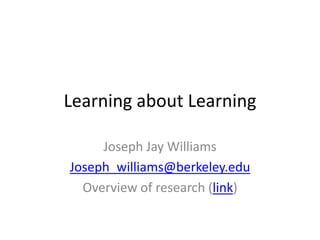
Cognitive science research to promote online education
- 1. Learning about Learning Joseph Jay Williams Joseph_williams@berkeley.edu Overview of research (link)
- 2. Goal • In the opinion of X, what’s the best way to learn or teach a topic? – (X is you, a student, a teacher, instructional/curriculum designer, a businessperson) • How would X’s answer change based on being exposed to research from cognitive science & education?
- 3. Overview • Framework: Encourage Transfer Appropriate Processing • Retrieval Practice & Testing Effects • Problem-based learning & case-based reasoning • Analogy & Comparison • Explanation • Research on “behavior change” may be relevant (BJ Fogg’s Behavior Change Model, CBT, habit formation) • Using technology to expand what learners “know”
- 4. Some analogies for how people might think learning works • Bucket model of the • Integrating a webpage mind into the internet • Instructionism • Need to think actively about your learning
- 5. What are the goals for student learning? • Transfer Appropriate Processing • What knowledge do you want students to acquire? – Memory, Understanding, Ability to make predictions & solve problems? – Facts, Procedures, Concepts, Relations between Concepts, Explanations, Causal Relationships? • In what situations will students use the knowledge? • How will the knowledge be integrated with knowledge the students already have? • How will adding this knowledge cause students to have different future thoughts, actions, and behaviors?
- 6. (Retrieval) practice makes perfect • Use what you want them to learn in the contexts you want them to use it in (Karpicke & Blunt, 2011) • Retrieve it and apply it to the context you wanted to: reason about situations & make attributions as well as ponder, recall and apply rather than reread, explain to another person as well as think about it
- 7. Where will they use knowledge? • Problem Based Learning (Hmelo-Silver, 2006) • Case based reasoning (Kolodner, 1997
- 8. How does it relate to what they already know? • What is it that they already “know”? • What would be concrete, powerful analogies? (Gentner, 2010) • Comparison of old & new ideas (Gentner et al, 2003)
- 9. How will the new knowledge change learners’ thoughts & behavior? • Not just giving, but soliciting explanations (Chi, 2000; Siegler, 2005; Wellman & Liu, 2006; Chouinard, 2008) • Kinds of explanations? E.g. Asking questions vs. Understanding vs. Explaining why • Explain to a friend • Explain why a fact • Explain why a learning strategy is helpful/unhelpful • Explain how what was learned applies to specific cases • Explain how what was learned could be used in future situations
- 10. Synergy between learning and behavior change • Need to link responses and knowledge to specific and distinct cues & situations • In addition to having knowledge, the habit of using that knowledge at the right moment • Environmental support • Technological support: – Daily logging – Text messaging – Interactive programs – Games
- 11. Use technology to expand what learners’ “know”: what they can readily access & apply • “Knowing” by being skilled at finding information – Google, Wikipedia, WikiHow, Lifehacker, Google Scholar • “Knowing” by being aware of who to ask • “Remembering” by storing, organizing, and regularly accessing a personal knowledge base or “electronic brain” – (Google Docs, Evernote, Mendeley) • “Remembering” steps for learning/problem- solving by creating & regularly using apps, checklists and step-by-step guides
Notes de l'éditeur
- Vast number of potentially relevant contexts a mindset can be applied, may rely on different domains of knowledge: it’s less like learning math or biology and more like changing “problem-solving ability”, learning CBT, interpersonal skills, nutrition habits
